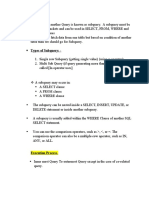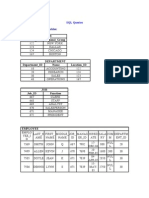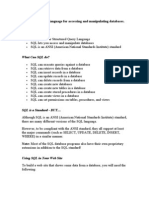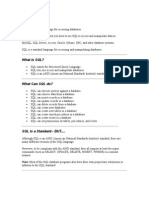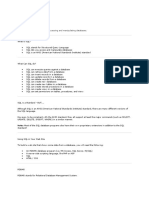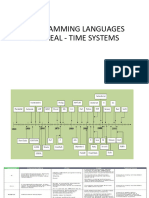Introduction to SQL
SQL is a standard language for accessing and manipulating databases.
What is SQL?
SQL stands for Structured Query Language SQL lets you access and manipulate databases SQL is an ANSI (American National Standards Institute) standard
What Can SQL do?
SQL SQL SQL SQL SQL SQL SQL SQL SQL SQL can can can can can can can can can can execute queries against a database retrieve data from a database insert records in a database update records in a database delete records from a database create new databases create new tables in a database create stored procedures in a database create views in a database set permissions on tables, procedures, and views
SQL is a Standard - BUT....
Although SQL is an ANSI (American National Standards Institute) standard, there are many different versions of the SQL language. However, to be compliant with the ANSI standard, they all support at least the major commands (such as SELECT, UPDATE, DELETE, INSERT, WHERE) in a similar manner.
Using SQL in Your Web Site
To build a web site that shows some data from a database, you will need the following:
An RDBMS database program (i.e. MS Access, SQL Server, MySQL) A server-side scripting language, like PHP or ASP SQL HTML / CSS
RDBMS
RDBMS stands for Relational Database Management System. RDBMS is the basis for SQL, and for all modern database systems like MS SQL Server, IBM DB2, Oracle, MySQL, and Microsoft Access. The data in RDBMS is stored in database objects called tables.
�A table is a collections of related data entries and it consists of columns and rows.
SQL Syntax
Database Tables
A database most often contains one or more tables. Each table is identified by a name (e.g. "Customers" or "Orders"). Tables contain records (rows) with data. Below is an example of a table called "Persons": P_Id 1 2 3 LastName Hansen Svendson Pettersen FirstName Ola Tove Kari Address Timoteivn 10 Borgvn 23 Storgt 20 City Sandnes Sandnes Stavanger
The table above contains three records (one for each person) and five columns (P_Id, LastName, FirstName, Address, and City).
SQL Statements
Most of the actions you need to perform on a database are done with SQL statements. The following SQL statement will select all the records in the "Persons" table:
SELECT * FROM Persons
Keep in Mind That...
SQL is not case sensitive
Semicolon after SQL Statements?
Some database systems require a semicolon at the end of each SQL statement. Semicolon is the standard way to separate each SQL statement in database systems that allow more than one SQL statement to be executed in the same call to the server.
SQL DML and DDL
SQL can be divided into two parts: The Data Manipulation Language (DML) and the Data Definition Language (DDL). The query and update commands form the DML part of SQL:
SELECT - extracts data from a database UPDATE - updates data in a database DELETE - deletes data from a database INSERT INTO - inserts new data into a database
The DDL part of SQL permits database tables to be created or deleted. It also define indexes (keys), specify links between tables, and impose constraints between tables. The most important DDL statements in SQL are:
CREATE DATABASE - creates a new database ALTER DATABASE - modifies a database CREATE TABLE - creates a new table ALTER TABLE - modifies a table DROP TABLE - deletes a table CREATE INDEX - creates an index (search key) DROP INDEX - deletes an index
SQL SELECT Statement
The SQL SELECT Statement
The SELECT statement is used to select data from a database. The result is stored in a result table, called the result-set.
SQL SELECT Syntax
SELECT column_name(s) FROM table_name
And
SELECT * FROM table_name
An SQL SELECT Example
The "Persons" table: P_Id 1 2 3 LastName Hansen Svendson Pettersen FirstName Ola Tove Kari Address Timoteivn 10 Borgvn 23 Storgt 20 City Sandnes Sandnes Stavanger
Now we want to select the content of the columns named "LastName" and "FirstName" from the table above. We use the following SELECT statement:
�SELECT LastName,FirstName FROM Persons
The result-set will look like this: LastName Hansen Svendson Pettersen FirstName Ola Tove Kari
SELECT * Example
Now we want to select all the columns from the "Persons" table. We use the following SELECT statement:
SELECT * FROM Persons
The asterisk (*) is a quick way of selecting all columns! The result-set will look like this: P_Id 1 2 3 LastName Hansen Svendson Pettersen FirstName Ola Tove Kari Address Timoteivn 10 Borgvn 23 Storgt 20 City Sandnes Sandnes Stavanger
SQL SELECT DISTINCT Statement
The SQL SELECT DISTINCT Statement
In a table, some of the columns may contain duplicate values. This is not a problem, however, sometimes you will want to list only the different (distinct) values in a table. The DISTINCT keyword can be used to return only distinct (different) values.
SQL SELECT DISTINCT Syntax
SELECT DISTINCT column_name(s) FROM table_name
SELECT DISTINCT Example
The "Persons" table: P_Id LastName FirstName Address City
�1 2 3
Hansen Svendson Pettersen
Ola Tove Kari
Timoteivn 10 Borgvn 23 Storgt 20
Sandnes Sandnes Stavanger
Now we want to select only the distinct values from the column named "City" from the table above. We use the following SELECT statement:
SELECT DISTINCT City FROM Persons
The result-set will look like this: City Sandnes Stavanger
SQL WHERE Clause
The WHERE clause is used to filter records.
The WHERE Clause
The WHERE clause is used to extract only those records that fulfill a specified criterion.
SQL WHERE Syntax
SELECT column_name(s) FROM table_name WHERE column_name operator value
WHERE Clause Example
The "Persons" table: P_Id 1 2 3 LastName Hansen Svendson Pettersen FirstName Ola Tove Kari Address Timoteivn 10 Borgvn 23 Storgt 20 City Sandnes Sandnes Stavanger
Now we want to select only the persons living in the city "Sandnes" from the table above. We use the following SELECT statement:
�SELECT * FROM Persons WHERE City='Sandnes'
The result-set will look like this: P_Id 1 2 LastName Hansen Svendson FirstName Ola Tove Address Timoteivn 10 Borgvn 23 City Sandnes Sandnes
Quotes Around Text Fields
SQL uses single quotes around text values (most database systems will also accept double quotes). Although, numeric values should not be enclosed in quotes. For text values:
This is correct: SELECT * FROM Persons WHERE FirstName='Tove' This is wrong: SELECT * FROM Persons WHERE FirstName=Tove
For numeric values:
This is correct: SELECT * FROM Persons WHERE Year=1965 This is wrong: SELECT * FROM Persons WHERE Year='1965'
Operators Allowed in the WHERE Clause
With the WHERE clause, the following operators can be used: Operator = <> > < >= Equal Not equal Greater than Less than Greater than or equal Description
�<= BETWEEN LIKE IN
Less than or equal Between an inclusive range Search for a pattern If you know the exact value you want to return for at least one of the columns
In some versions of SQL the <> operator may be written as !=
SQL AND & OR Operators
The AND & OR operators are used to filter records based on more than one condition.
The AND & OR Operators
The AND operator displays a record if both the first condition and the second condition is true. The OR operator displays a record if either the first condition or the second condition is true.
AND Operator Example
The "Persons" table: P_Id 1 2 3 LastName Hansen Svendson Pettersen FirstName Ola Tove Kari Address Timoteivn 10 Borgvn 23 Storgt 20 City Sandnes Sandnes Stavanger
Now we want to select only the persons with the first name equal to "Tove" AND the last name equal to "Svendson": We use the following SELECT statement:
SELECT * FROM Persons WHERE FirstName='Tove' AND LastName='Svendson'
The result-set will look like this: P_Id LastName FirstName Address City
Svendson
Tove
Borgvn 23
Sandnes
OR Operator Example
Now we want to select only the persons with the first name equal to "Tove" OR the first name equal to "Ola": We use the following SELECT statement:
SELECT * FROM Persons WHERE FirstName='Tove' OR FirstName='Ola'
The result-set will look like this: P_Id 1 2 LastName Hansen Svendson FirstName Ola Tove Address Timoteivn 10 Borgvn 23 City Sandnes Sandnes
Combining AND & OR
You can also combine AND and OR (use parenthesis to form complex expressions). Now we want to select only the persons with the last name equal to "Svendson" AND the first name equal to "Tove" OR to "Ola": We use the following SELECT statement:
SELECT * FROM Persons WHERE LastName='Svendson' AND (FirstName='Tove' OR FirstName='Ola')
The result-set will look like this: P_Id 2 LastName Svendson FirstName Tove Address Borgvn 23 City Sandnes
SQL ORDER BY Keyword
The ORDER BY keyword is used to sort the result-set.
The ORDER BY Keyword
The ORDER BY keyword is used to sort the result-set by a specified column.
�The ORDER BY keyword sort the records in ascending order by default. If you want to sort the records in a descending order, you can use the DESC keyword.
SQL ORDER BY Syntax
SELECT column_name(s) FROM table_name ORDER BY column_name(s) ASC|DESC
ORDER BY Example
The "Persons" table: P_Id 1 2 3 4 LastName Hansen Svendson Pettersen Nilsen FirstName Ola Tove Kari Tom Address Timoteivn 10 Borgvn 23 Storgt 20 Vingvn 23 City Sandnes Sandnes Stavanger Stavanger
Now we want to select all the persons from the table above, however, we want to sort the persons by their last name. We use the following SELECT statement:
SELECT * FROM Persons ORDER BY LastName
The result-set will look like this: P_Id 1 4 3 2 LastName Hansen Nilsen Pettersen Svendson FirstName Ola Tom Kari Tove Address Timoteivn 10 Vingvn 23 Storgt 20 Borgvn 23 City Sandnes Stavanger Stavanger Sandnes
ORDER BY DESC Example
Now we want to select all the persons from the table above, however, we want to sort the persons descending by their last name. We use the following SELECT statement:
SELECT * FROM Persons ORDER BY LastName DESC
�The result-set will look like this: P_Id 2 3 4 1 LastName Svendson Pettersen Nilsen Hansen FirstName Tove Kari Tom Ola Address Borgvn 23 Storgt 20 Vingvn 23 Timoteivn 10 City Sandnes Stavanger Stavanger Sandnes
SQL INSERT INTO Statement
The INSERT INTO statement is used to insert new records in a table.
The INSERT INTO Statement
The INSERT INTO statement is used to insert a new row in a table.
SQL INSERT INTO Syntax
It is possible to write the INSERT INTO statement in two forms. The first form doesn't specify the column names where the data will be inserted, only their values:
INSERT INTO table_name VALUES (value1, value2, value3,...)
The second form specifies both the column names and the values to be inserted:
INSERT INTO table_name (column1, column2, column3,...) VALUES (value1, value2, value3,...)
SQL INSERT INTO Example
We have the following "Persons" table: P_Id 1 2 3 LastName Hansen Svendson Pettersen FirstName Ola Tove Kari Address Timoteivn 10 Borgvn 23 Storgt 20 City Sandnes Sandnes Stavanger
�Now we want to insert a new row in the "Persons" table. We use the following SQL statement:
INSERT INTO Persons VALUES (4,'Nilsen', 'Johan', 'Bakken 2', 'Stavanger')
The "Persons" table will now look like this: P_Id 1 2 3 4 LastName Hansen Svendson Pettersen Nilsen FirstName Ola Tove Kari Johan Address Timoteivn 10 Borgvn 23 Storgt 20 Bakken 2 City Sandnes Sandnes Stavanger Stavanger
Insert Data Only in Specified Columns
It is also possible to only add data in specific columns. The following SQL statement will add a new row, but only add data in the "P_Id", "LastName" and the "FirstName" columns:
INSERT INTO Persons (P_Id, LastName, FirstName) VALUES (5, 'Tjessem', 'Jakob')
The "Persons" table will now look like this: P_Id 1 2 3 4 5 LastName Hansen Svendson Pettersen Nilsen Tjessem FirstName Ola Tove Kari Johan Jakob Address Timoteivn 10 Borgvn 23 Storgt 20 Bakken 2 City Sandnes Sandnes Stavanger Stavanger
�SQL UPDATE Statement
The UPDATE statement is used to update records in a table.
The UPDATE Statement
The UPDATE statement is used to update existing records in a table.
SQL UPDATE Syntax
UPDATE table_name SET column1=value, column2=value2,... WHERE some_column=some_value
Note: Notice the WHERE clause in the UPDATE syntax. The WHERE clause specifies which record or records that should be updated. If you omit the WHERE clause, all records will be updated!
SQL UPDATE Example
The "Persons" table: P_Id 1 2 3 4 5 LastName Hansen Svendson Pettersen Nilsen Tjessem FirstName Ola Tove Kari Johan Jakob Address Timoteivn 10 Borgvn 23 Storgt 20 Bakken 2 City Sandnes Sandnes Stavanger Stavanger
Now we want to update the person "Tjessem, Jakob" in the "Persons" table. We use the following SQL statement:
UPDATE Persons SET Address='Nissestien 67', City='Sandnes' WHERE LastName='Tjessem' AND FirstName='Jakob'
The "Persons" table will now look like this: P_Id 1 LastName Hansen FirstName Ola Address Timoteivn 10 City Sandnes
�2 3 4 5
Svendson Pettersen Nilsen Tjessem
Tove Kari Johan Jakob
Borgvn 23 Storgt 20 Bakken 2 Nissestien 67
Sandnes Stavanger Stavanger Sandnes
SQL UPDATE Warning
Be careful when updating records. If we had omitted the WHERE clause in the example above, like this:
UPDATE Persons SET Address='Nissestien 67', City='Sandnes'
The "Persons" table would have looked like this: P_Id 1 2 3 4 5 LastName Hansen Svendson Pettersen Nilsen Tjessem FirstName Ola Tove Kari Johan Jakob Address Nissestien 67 Nissestien 67 Nissestien 67 Nissestien 67 Nissestien 67 City Sandnes Sandnes Sandnes Sandnes Sandnes
SQL DELETE Statement
The DELETE statement is used to delete records in a table.
The DELETE Statement
The DELETE statement is used to delete rows in a table.
SQL DELETE Syntax
DELETE FROM table_name WHERE some_column=some_value
�Note: Notice the WHERE clause in the DELETE syntax. The WHERE clause specifies which record or records that should be deleted. If you omit the WHERE clause, all records will be deleted!
SQL DELETE Example
The "Persons" table: P_Id 1 2 3 4 5 LastName Hansen Svendson Pettersen Nilsen Tjessem FirstName Ola Tove Kari Johan Jakob Address Timoteivn 10 Borgvn 23 Storgt 20 Bakken 2 Nissestien 67 City Sandnes Sandnes Stavanger Stavanger Sandnes
Now we want to delete the person "Tjessem, Jakob" in the "Persons" table. We use the following SQL statement:
DELETE FROM Persons WHERE LastName='Tjessem' AND FirstName='Jakob'
The "Persons" table will now look like this: P_Id 1 2 3 4 LastName Hansen Svendson Pettersen Nilsen FirstName Ola Tove Kari Johan Address Timoteivn 10 Borgvn 23 Storgt 20 Bakken 2 City Sandnes Sandnes Stavanger Stavanger
Delete All Rows
It is possible to delete all rows in a table without deleting the table. This means that the table structure, attributes, and indexes will be intact:
DELETE FROM table_name
�or DELETE * FROM table_name
Be very careful when deleting records. You cannot undo this statement!
SQL DROP INDEX, DROP TABLE, and DROP DATABASE
Indexes, tables, and databases can easily be deleted/removed with the DROP statement.
The DROP TABLE Statement
The DROP TABLE statement is used to delete a table.
DROP TABLE table_name
The DROP DATABASE Statement
The DROP DATABASE statement is used to delete a database.
DROP DATABASE database_name
The TRUNCATE TABLE Statement
What if we only want to delete the data inside the table, and not the table itself? Then, use the TRUNCATE TABLE statement:
TRUNCATE TABLE table_name
SQL ALTER TABLE Statement
The ALTER TABLE Statement
The ALTER TABLE statement is used to add, delete, or modify columns in an existing table.
�SQL ALTER TABLE Syntax
To add a column in a table, use the following syntax:
ALTER TABLE table_name ADD column_name datatype
To delete a column in a table, use the following syntax (notice that some database systems don't allow deleting a column):
ALTER TABLE table_name DROP COLUMN column_name
To change the data type of a column in a table, use the following syntax:
ALTER TABLE table_name ALTER COLUMN column_name datatype
SQL ALTER TABLE Example
Look at the "Persons" table: P_Id 1 2 3 LastName Hansen Svendson Pettersen FirstName Ola Tove Kari Address Timoteivn 10 Borgvn 23 Storgt 20 City Sandnes Sandnes Stavanger
Now we want to add a column named "DateOfBirth" in the "Persons" table. We use the following SQL statement:
ALTER TABLE Persons ADD DateOfBirth date
Notice that the new column, "DateOfBirth", is of type date and is going to hold a date. The data type specifies what type of data the column can hold. For a complete reference of all the data types available in MS Access, MySQL, and SQL Server, go to our complete Data Types reference. The "Persons" table will now like this:
�P_Id 1 2 3
LastName Hansen Svendson Pettersen
FirstName Ola Tove Kari
Address Timoteivn 10 Borgvn 23 Storgt 20
City Sandnes Sandnes Stavanger
DateOfBirth
Change Data Type Example
Now we want to change the data type of the column named "DateOfBirth" in the "Persons" table. We use the following SQL statement:
ALTER TABLE Persons ALTER COLUMN DateOfBirth year
Notice that the "DateOfBirth" column is now of type year and is going to hold a year in a two-digit or fourdigit format.
DROP COLUMN Example
Next, we want to delete the column named "DateOfBirth" in the "Persons" table. We use the following SQL statement:
ALTER TABLE Persons DROP COLUMN DateOfBirth
The "Persons" table will now like this: P_Id 1 2 3 LastName Hansen Svendson Pettersen FirstName Ola Tove Kari Address Timoteivn 10 Borgvn 23 Storgt 20 City Sandnes Sandnes Stavanger
�SQL IN Operator
The IN Operator
The IN operator allows you to specify multiple values in a WHERE clause.
SQL IN Syntax
SELECT column_name(s) FROM table_name WHERE column_name IN (value1,value2,...)
IN Operator Example
The "Persons" table: P_Id 1 2 3 LastName Hansen Svendson Pettersen FirstName Ola Tove Kari Address Timoteivn 10 Borgvn 23 Storgt 20 City Sandnes Sandnes Stavanger
Now we want to select the persons with a last name equal to "Hansen" or "Pettersen" from the table above. We use the following SELECT statement:
SELECT * FROM Persons WHERE LastName IN ('Hansen','Pettersen')
The result-set will look like this: P_Id 1 3 LastName Hansen Pettersen FirstName Ola Kari Address Timoteivn 10 Storgt 20 City Sandnes Stavanger
SQL BETWEEN Operator
�The BETWEEN operator is used in a WHERE clause to select a range of data between two values.
The BETWEEN Operator
The BETWEEN operator selects a range of data between two values. The values can be numbers, text, or dates.
SQL BETWEEN Syntax
SELECT column_name(s) FROM table_name WHERE column_name BETWEEN value1 AND value2
BETWEEN Operator Example
The "Persons" table: P_Id 1 2 3 LastName Hansen Svendson Pettersen FirstName Ola Tove Kari Address Timoteivn 10 Borgvn 23 Storgt 20 City Sandnes Sandnes Stavanger
Now we want to select the persons with a last name alphabetically between "Hansen" and "Pettersen" from the table above. We use the following SELECT statement:
SELECT * FROM Persons WHERE LastName BETWEEN 'Hansen' AND 'Pettersen'
The result-set will look like this: P_Id 1 LastName Hansen FirstName Ola Address Timoteivn 10 City Sandnes
Note: The BETWEEN operator is treated differently in different databases.
�In some databases, persons with the LastName of "Hansen" or "Pettersen" will not be listed, because the BETWEEN operator only selects fields that are between and excluding the test values). In other databases, persons with the LastName of "Hansen" or "Pettersen" will be listed, because the BETWEEN operator selects fields that are between and including the test values). And in other databases, persons with the LastName of "Hansen" will be listed, but "Pettersen" will not be listed (like the example above), because the BETWEEN operator selects fields between the test values, including the first test value and excluding the last test value. Therefore: Check how your database treats the BETWEEN operator.
Example 2
To display the persons outside the range in the previous example, use NOT BETWEEN:
SELECT * FROM Persons WHERE LastName NOT BETWEEN 'Hansen' AND 'Pettersen'
The result-set will look like this: P_Id 2 3 LastName Svendson Pettersen FirstName Tove Kari Address Borgvn 23 Storgt 20 City Sandnes Stavanger
SQL NOT NULL Constraint
By default, a table column can hold NULL values.
SQL NOT NULL Constraint
The NOT NULL constraint enforces a column to NOT accept NULL values. The NOT NULL constraint enforces a field to always contain a value. This means that you cannot insert a new record, or update a record without adding a value to this field. The following SQL enforces the "P_Id" column and the "LastName" column to not accept NULL values:
CREATE TABLE Persons ( P_Id int NOT NULL, LastName varchar(255) NOT NULL, FirstName varchar(255),
�Address varchar(255), City varchar(255) )
SQL UNIQUE Constraint
SQL UNIQUE Constraint
The UNIQUE constraint uniquely identifies each record in a database table. The UNIQUE and PRIMARY KEY constraints both provide a guarantee for uniqueness for a column or set of columns. A PRIMARY KEY constraint automatically has a UNIQUE constraint defined on it. Note that you can have many UNIQUE constraints per table, but only one PRIMARY KEY constraint per table. SQL Server / Oracle / MS Access:
CREATE TABLE Persons ( P_Id int NOT NULL UNIQUE, LastName varchar(255) NOT NULL, FirstName varchar(255), Address varchar(255), City varchar(255) )
To DROP a UNIQUE Constraint
To drop a UNIQUE constraint, use the following SQL: SQL Server / Oracle / MS Access:
ALTER TABLE Persons DROP CONSTRAINT uc_PersonID
SQL PRIMARY KEY Constraint
SQL PRIMARY KEY Constraint
The PRIMARY KEY constraint uniquely identifies each record in a database table. Primary keys must contain unique values. A primary key column cannot contain NULL values.
�Each table should have a primary key, and each table can have only one primary key.
SQL PRIMARY KEY Constraint on CREATE TABLE
The following SQL creates a PRIMARY KEY on the "P_Id" column when the "Persons" table is created: SQL Server / Oracle / MS Access:
CREATE TABLE Persons ( P_Id int NOT NULL PRIMARY KEY, LastName varchar(255) NOT NULL, FirstName varchar(255), Address varchar(255), City varchar(255) )
SQL PRIMARY KEY Constraint on ALTER TABLE
To create a PRIMARY KEY constraint on the "P_Id" column when the table is already created, use the following SQL: MySQL / SQL Server / Oracle / MS Access:
ALTER TABLE Persons ADD PRIMARY KEY (P_Id)
To DROP a PRIMARY KEY Constraint
To drop a PRIMARY KEY constraint, use the following SQL: SQL Server / Oracle / MS Access:
ALTER TABLE Persons DROP CONSTRAINT pk_PersonID




